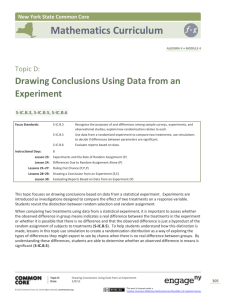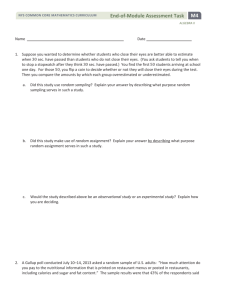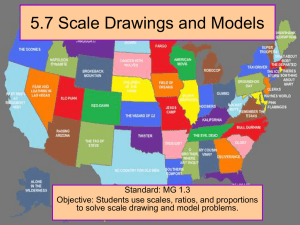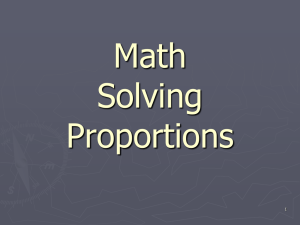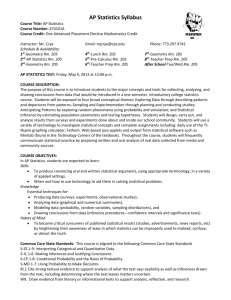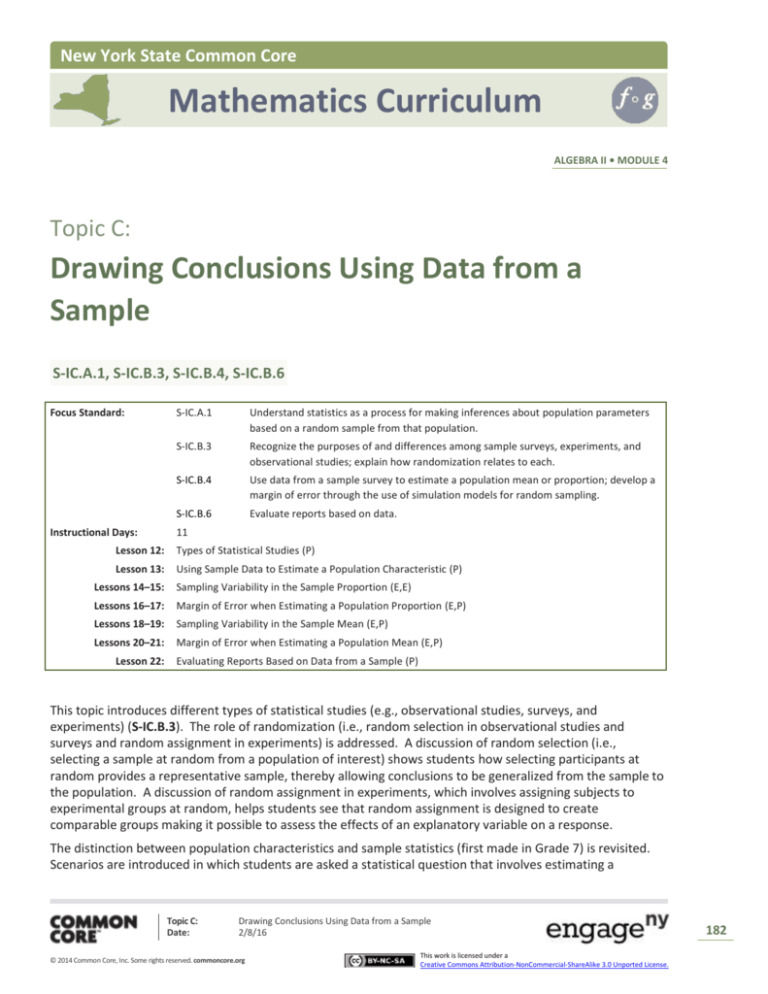
New York State Common Core
Mathematics Curriculum
ALGEBRA II • MODULE 4
Topic C:
Drawing Conclusions Using Data from a
Sample
S-IC.A.1, S-IC.B.3, S-IC.B.4, S-IC.B.6
Focus Standard:
Instructional Days:
S-IC.A.1
Understand statistics as a process for making inferences about population parameters
based on a random sample from that population.
S-IC.B.3
Recognize the purposes of and differences among sample surveys, experiments, and
observational studies; explain how randomization relates to each.
S-IC.B.4
Use data from a sample survey to estimate a population mean or proportion; develop a
margin of error through the use of simulation models for random sampling.
S-IC.B.6
Evaluate reports based on data.
11
Lesson 12:
Types of Statistical Studies (P)
Lesson 13:
Using Sample Data to Estimate a Population Characteristic (P)
Lessons 14–15:
Sampling Variability in the Sample Proportion (E,E)
Lessons 16–17:
Margin of Error when Estimating a Population Proportion (E,P)
Lessons 18–19:
Sampling Variability in the Sample Mean (E,P)
Lessons 20–21:
Margin of Error when Estimating a Population Mean (E,P)
Lesson 22:
Evaluating Reports Based on Data from a Sample (P)
This topic introduces different types of statistical studies (e.g., observational studies, surveys, and
experiments) (S-IC.B.3). The role of randomization (i.e., random selection in observational studies and
surveys and random assignment in experiments) is addressed. A discussion of random selection (i.e.,
selecting a sample at random from a population of interest) shows students how selecting participants at
random provides a representative sample, thereby allowing conclusions to be generalized from the sample to
the population. A discussion of random assignment in experiments, which involves assigning subjects to
experimental groups at random, helps students see that random assignment is designed to create
comparable groups making it possible to assess the effects of an explanatory variable on a response.
The distinction between population characteristics and sample statistics (first made in Grade 7) is revisited.
Scenarios are introduced in which students are asked a statistical question that involves estimating a
Topic C:
Date:
Drawing Conclusions Using Data from a Sample
2/8/16
© 2014 Common Core, Inc. Some rights reserved. commoncore.org
This work is licensed under a
Creative Commons Attribution-NonCommercial-ShareAlike 3.0 Unported License.
182
Topic C
NYS COMMON CORE MATHEMATICS CURRICULUM
M4
ALGEBRA II
population mean or a population proportion. For example, students are asked to define an appropriate
population, population characteristic, sample, and sample statistics that might be used in a study of the time
it takes students to run a quarter-mile or a study of the proportion of national parks that contain bald eagle
nests.
In this topic, students use data from a random sample to estimate a population mean or a population
proportion. Building on what they learned about sampling variability in Grade 7, students use simulation to
create an understanding of margin of error. In Grade 7, students learned that the proportion of successes in a
random sample from a population will vary from sample to sample due to the random selection process.
They understand that the value of the sample proportion will not be exactly equal to the value of the
population proportion. In Grade 11, they use margin of error to describe how different the value of the
sample proportion might be from the value of the population proportion. Students begin by using a physical
simulation process to carry out a simulation. Starting with a population that contains 40% successes (using a
bag with 40 black beans and 60 white beans), they select random samples from the population and calculate
the sample proportion. By doing this many times, they are able to get a sense of what kind of differences are
likely. Their understanding should then extend to include the concept of margin of error. Students then
proceed to use technology to carry out a simulation. Once students understand the concept of margin of
error, they go on to learn how to calculate and interpret it in context (S-IC.A.1, S-IC.B.4). Students also
evaluate reports from the media in which sample data is used to estimate a population mean or proportion
(S-IC.B.6).
Topic C:
Date:
Drawing Conclusions Using Data from a Sample
2/8/16
© 2014 Common Core, Inc. Some rights reserved. commoncore.org
This work is licensed under a
Creative Commons Attribution-NonCommercial-ShareAlike 3.0 Unported License.
183

